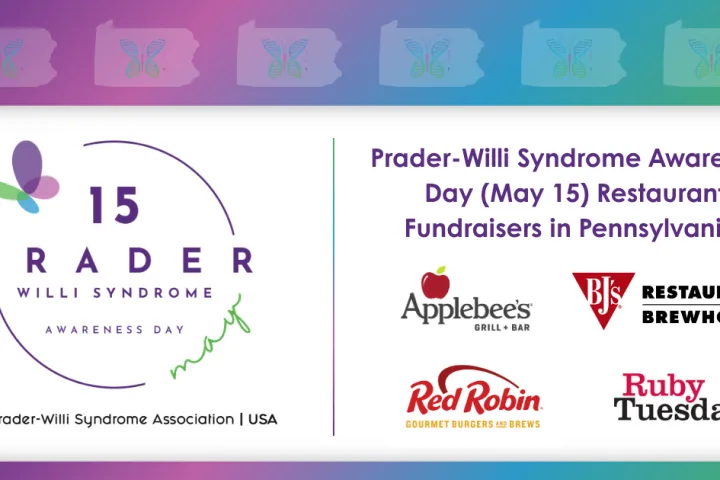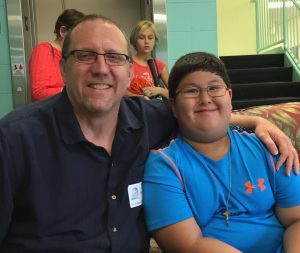Contributed by Stacy Ward, MS Director of Family Support and Lynn Garrick, RN, BSN Medical/Research Coordinator
Prader-Willi syndrome (PWS) is a rare neurodevelopmental genetic disorder that affects multiple systems in the body. There are many symptoms of PWS, including hyperphagia, behavioral challenges, hypotonia, incomplete sexual development, cognitive deficits, metabolic dysregulation, and several more. Hyperphagia is often a misunderstood symptom of PWS by the school system.
Hyperphagia is defined as an “intense persistent sensation of hunger accompanied by food preoccupations, an extreme drive to consume food, food-related behavior problems, and a lack of normal satiety” by the International Clinical Trial Consortium's consensus paper Behavioral Features in Prader-Willi Syndrome (2021). As with all symptoms of PWS, hyperphagia severity varies from person-to-person. The Hyperphagia Questionnaire developed by Dykens et. al (2007) separated hyperphagia into three distinct categories: hyperphagic behaviors, hyperphagic drive and hyperphagic severity. This highlights that hyperphagia is not only actively food-seeking or eating as often believed. Hyperphagia is one of the effects of impaired development of the hypothalamus and the brain pathways that control eating behavior. What is critical to understand is that this is not the student’s fault that they are unable to consistently regulate their food intake or thoughts about food without ongoing support; despite some of the believable proclamations that they can.
Hyperphagic behaviors include being preoccupied or distracted by the thought, smell, or presence of food, perseverative talking about food, increased anxiety symptoms when food is present, or food-related schedule change and bargaining to obtain more or different food. In the classroom, it can be difficult to know when distracted or off-task behavior is related to hyperphagia or the function of something else. Therefore, implementing and maintaining a food secure environment is necessary. Creating and maintaining a food secure environment is an essential part for achieving academic goals.
What is food security in the classroom? All lunches and snacks are stored securely in cubbies or out of sight. Snacks and lunch are planned and occur at the same time every day. If participating in a school lunch program, picking out menu items that are part of their prescribed meal plan in advance, may avoid some hyperphagic behaviors. For example, some schools will hand out the lunch menu several weeks ahead of time. Having the parent or guardian circle acceptable choices for the upcoming weeks may be helpful. Avoid reading books that are food focused or using word math problems with food (six apples etc.). Avoid field trips that are solely food focused or adding special food treats at the end of a field trip. If there are celebrations or food activities, attempt to use nonfood related treats/activities. If food-related activities are unavoidable, communication with the parent/guardian to plan the amount and type of food the student can safely have, may avoid conflict. It is recognized food-related school functions are typically a time for socialization with peers and for building meaningful relationships. Awareness of developmental, social, health and educational needs should be given careful consideration when providing support for the student with PWS. For some students, a 1:1 helper/Para may be needed to maintain safety and food security both during times of food consumption and activities that may invoke feelings of food insecurity. Celebrate holidays and special occasions with cultural crafts and stories rather than food. Refrain from using lunch boxes or food containers to develop fine motor skills in therapy sessions. Practicing opening these things will most certainly increase anxiety and increase hyperphagic behaviors.
As educators and therapists, you may not observe overt food seeking behavior when food security is not in place. You may observe the student with PWS refusing to complete work, become agitated or aggressive, disengage from the task, put their head down or “daydream” instead. When these other hyperphagic behaviors occur, immediately examine the environment. Was there a change in the schedule or food in the curriculum? Is there food present right now? An additional complication is that the student may be able to maintain their composure until they get home and feel “safe enough” to fall apart. Continuous, open and honest communication with parents is necessary for the student’s safety and success in school. Structure, consistency in approach and food security are the keys to success for those with PWS.
To learn more about educating and supporting students with PWS, go to pwsausa.org/schoolsuccess/.
Share this!





 Jennifer Bolander has been serving as a Special Education Specialist for PWSA (USA) since October of 2015. She is a graduate of John Carroll University and lives in Ohio with her husband Brad and daughters Kate (17), and Sophia (13) who was born with PWS.
Jennifer Bolander has been serving as a Special Education Specialist for PWSA (USA) since October of 2015. She is a graduate of John Carroll University and lives in Ohio with her husband Brad and daughters Kate (17), and Sophia (13) who was born with PWS. Perry A. Zirkel has written more than 1,500 publications on various aspects of school law, with an emphasis on legal issues in special education. He writes a regular column for NAESP’s Principal magazine and NASP’s Communiqué newsletter, and he did so previously for Phi Delta Kappan and Teaching Exceptional Children.
Perry A. Zirkel has written more than 1,500 publications on various aspects of school law, with an emphasis on legal issues in special education. He writes a regular column for NAESP’s Principal magazine and NASP’s Communiqué newsletter, and he did so previously for Phi Delta Kappan and Teaching Exceptional Children. Evan has worked with the Prader-Willi Syndrome Association (USA) since 2007 primarily as a Crisis Intervention and Family Support Counselor. Evans works with parents and schools to foster strong collaborative relationships and appropriate educational environments for students with PWS.
Evan has worked with the Prader-Willi Syndrome Association (USA) since 2007 primarily as a Crisis Intervention and Family Support Counselor. Evans works with parents and schools to foster strong collaborative relationships and appropriate educational environments for students with PWS. Dr. Amy McTighe is the PWS Program Manager and Inpatient Teacher at the Center for Prader-Willi Syndrome at the Children’s Institute of Pittsburgh. She graduated from Duquesne University receiving her Bachelor’s and Master’s degree in Education with a focus on elementary education, special education, and language arts.
Dr. Amy McTighe is the PWS Program Manager and Inpatient Teacher at the Center for Prader-Willi Syndrome at the Children’s Institute of Pittsburgh. She graduated from Duquesne University receiving her Bachelor’s and Master’s degree in Education with a focus on elementary education, special education, and language arts. Staci Zimmerman works for Prader-Willi Syndrome Association of Colorado as an Individualized Education Program (IEP) consultant. Staci collaborates with the PWS multi-disciplinary clinic at the Children’s Hospital in Denver supporting families and school districts around the United States with their child’s Individual Educational Plan.
Staci Zimmerman works for Prader-Willi Syndrome Association of Colorado as an Individualized Education Program (IEP) consultant. Staci collaborates with the PWS multi-disciplinary clinic at the Children’s Hospital in Denver supporting families and school districts around the United States with their child’s Individual Educational Plan. Founded in 2001, SDLC is a non-profit legal services organization dedicated to protecting and advancing the legal rights of people with disabilities throughout the South. It partners with the Southern Poverty Law Center, Protection and Advocacy (P&A) programs, Legal Services Corporations (LSC) and disability organizations on major, systemic disability rights issues involving the Individuals with Disabilities Education Act (IDEA), Americans with Disabilities Act (ADA), and the federal Medicaid Act. Recently in November 2014, Jim retired.
Founded in 2001, SDLC is a non-profit legal services organization dedicated to protecting and advancing the legal rights of people with disabilities throughout the South. It partners with the Southern Poverty Law Center, Protection and Advocacy (P&A) programs, Legal Services Corporations (LSC) and disability organizations on major, systemic disability rights issues involving the Individuals with Disabilities Education Act (IDEA), Americans with Disabilities Act (ADA), and the federal Medicaid Act. Recently in November 2014, Jim retired.